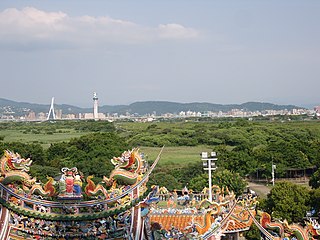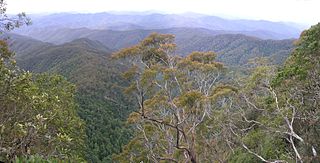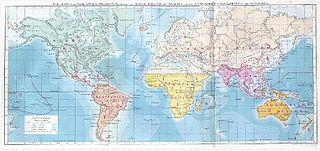Related Research Articles

A biome is a community of plants and animals that have common characteristics for the environment they exist in. They can be found over a range of continents. Biomes are distinct biological communities that have formed in response to a shared physical climate. Biome is a broader term than habitat; any biome can comprise a variety of habitats.

An ecoregion is an ecologically and geographically defined area that is smaller than a bioregion, which in turn is smaller than a biogeographic realm. Ecoregions cover relatively large areas of land or water, and contain characteristic, geographically distinct assemblages of natural communities and species. The biodiversity of flora, fauna and ecosystems that characterise an ecoregion tends to be distinct from that of other ecoregions. In theory, biodiversity or conservation ecoregions are relatively large areas of land or water where the probability of encountering different species and communities at any given point remains relatively constant, within an acceptable range of variation.

Protected areas or conservation areas are locations which receive protection because of their recognized natural, ecological or cultural values. There are several kinds of protected areas, which vary by level of protection depending on the enabling laws of each country or the regulations of the international organizations involved. Generally speaking though, protected areas are understood to be those in which human presence or at least the exploitation of resources is limited.
This is an index of conservation topics. It is an alphabetical index of articles relating to conservation biology and conservation of the natural environment.

Grasslands are areas where the vegetation is dominated by grasses (Poaceae). However, sedge (Cyperaceae) and rush (Juncaceae) can also be found along with variable proportions of legumes, like clover, and other herbs. Grasslands occur naturally on all continents except Antarctica and are found in most ecoregions of the Earth. Furthermore, grasslands are one of the largest biomes on earth and dominate the landscape worldwide. They cover 31-43% of the earth's surface. Moreover, they are one of our planet's most productive landscapes. There are different types of grasslands: natural grasslands, semi-natural grasslands, and agricultural grasslands.

Deserts and xeric shrublands are a habitat type defined by the World Wide Fund for Nature. Deserts and xeric shrublands form the largest terrestrial biome, covering 19% of Earth's land surface area. Ecoregions in this habitat type vary greatly in the amount of annual rainfall they receive, usually less than 250 millimetres (10 in) annually except in the margins. Generally evaporation exceeds rainfall in these ecoregions. Temperature variability is also diverse in these lands. Many deserts, such as the Sahara, are hot year-round, but others, such as East Asia's Gobi, become quite cold in winter.

Conservation biology is the management of nature and of Earth's biodiversity with the aim of protecting species, their habitats, and ecosystems from excessive rates of extinction and the erosion of biotic interactions. It is an interdisciplinary subject drawing on natural and social sciences, and the practice of natural resource management.

The Atlantic Forest is a South American forest that extends along the Atlantic coast of Brazil from Rio Grande do Norte state in the north to Rio Grande do Sul state in the south, and inland as far as Paraguay and the Misiones Province of Argentina, where the region is known as Selva Misionera.
A biodiversity hotspot is a biogeographic region with significant levels of biodiversity that is threatened by human habitation.

An Important Bird and Biodiversity Area (IBA) is an area identified using an internationally agreed set of criteria as being globally important for the conservation of bird populations.

The Cerrado is a vast tropical savanna ecoregion of Brazil, particularly in the states of Goiás, Mato Grosso do Sul, Mato Grosso, Tocantins, Minas Gerais and the Federal District. The Cerrado biome core areas are the plateaus in the center of Brazil. The main habitat types of the Cerrado include: forest savanna, wooded savanna, park savanna and gramineous-woody savanna. Savanna wetlands and gallery forests are also included. The second largest of Brazil's major habitat types, after the Amazonian rainforest, the Cerrado accounts for a full 21 percent of the country's land area.

The Meghalaya subtropical forests is an ecoregion of Northeast India. The ecoregion covers an area of 41,700 square kilometers (16,100 sq mi), and despite its name, comprise not only the state of Meghalaya, but also parts of southern Assam, and a tiny bit of Nagaland around Dimapur. It also contains many other habitats than subtropical forests, but the montane subtropical forests found in Meghalaya is an important biome, and was once much more widespread in the region, and for these reasons chosen as the most suitable name. The scientific designation is IM0126.

The Serra do Mar coastal forests is an ecoregion of the tropical moist forests biome, and of the South American Atlantic Forest biome.

The campo rupestre is a discontinuous montane subtropical ecoregion occurring across three different biomes in Brazil: Cerrado, Atlantic Forest and Caatinga. Originally, campo rupestre was used to characterize the montane vegetation of the Espinhaço Range, but recently this term has been broadly applied by the scientific community to define high altitudinal fire-prone areas dominated by grasslands and rocky outcrops.
An intact forest landscape (IFL) is an unbroken natural landscape of a forest ecosystem and its habitat–plant community components, in an extant forest zone. An IFL is a natural environment with no signs of significant human activity or habitat fragmentation, and of sufficient size to contain, support, and maintain the complex of indigenous biodiversity of viable populations of a wide range of genera and species, and their ecological effects.

The Eastern Australian temperate forests, or temperate eucalypt forests, are an ecoregion of open forest on uplands starting from the east coast of New South Wales in the South Coast to southern Queensland, Australia. Four distinguishable communities are found within this ecoregion: subtropical rainforest, subtropical dry rainforest, warm temperate rainforest, and cool temperate rainforest, where they may also grade to other biomes, depending on the location.
Important Plant Areas (IPA) is a programme set up in the UK, by the organisation Plantlife, to provide a framework for identifying and maintaining the richest sites for plant life, possibly within existing protected areas; though the protection of the IPA itself is not legally enforced. The term plant life in this case refers to any number of species, encompassing algae, fungi, lichens, liverworts, mosses, and wild vascular plants. IPAs are selected with the intention of focusing on the conservation of the important wild plant populations in these areas, and act as a subset in the broader context of Key Biodiversity Areas. Designating an IPA is intended to gain awareness and encourage long-term conservation through an 'ecosystem-based' approach.

Mediterranean forests, woodlands, and scrub is a biome defined by the World Wide Fund for Nature. The biome is generally characterized by dry summers and rainy winters, although in some areas rainfall may be uniform. Summers are typically hot in low-lying inland locations but can be cool near colder seas. Winters are typically mild to cool in low-lying locations but can be cold in inland and higher locations. All these ecoregions are highly distinctive, collectively harboring 10% of the Earth's plant species.

Biogeographic classification of India is the division of India according to biogeographic characteristics. Biogeography is the study of the distribution of species (biology), organisms, and ecosystems in geographic space and through geological time. India has a rich heritage of natural diversity. India ranks fourth in Asia and tenth in the world amongst the top 17 mega-diverse countries in the world. India harbours nearly 11% of the world’s floral diversity comprising over 17500 documented flowering plants, 6200 endemic species, 7500 medicinal plants and 246 globally threatened species in only 2.4% of world’s land area. India is also home to four biodiversity hotspots—Andaman & Nicobar Islands, Eastern Himalaya, Indo-Burma region, and the Western Ghats. Hence the importance of biogeographical study of India's natural heritage.

The Amazon biome contains the Amazon rainforest, an area of tropical rainforest, and other ecoregions that cover most of the Amazon basin and some adjacent areas to the north and east. The biome contains blackwater and whitewater flooded forest, lowland and montane terra firme forest, bamboo and palm forest, savanna, sandy heath and alpine tundra. Some areas are threatened by deforestation for timber and to make way for pasture or soybean plantations.
References
- ↑ Jonathan M. Hoekstra, Timothy M. Boucher, Taylor M. Ricketts, and Carter Roberts. Confronting a biome crisis: global disparities of habitat loss and protection. Ecology Letters, 8:23-29, 2005